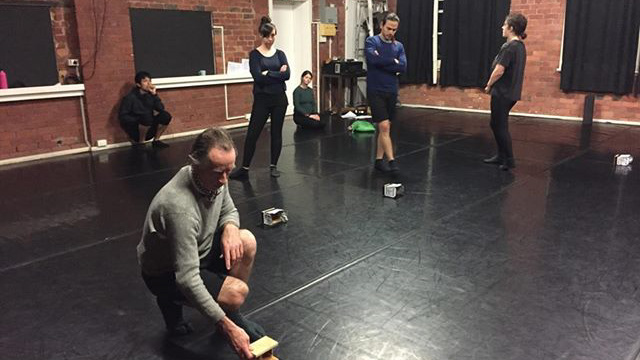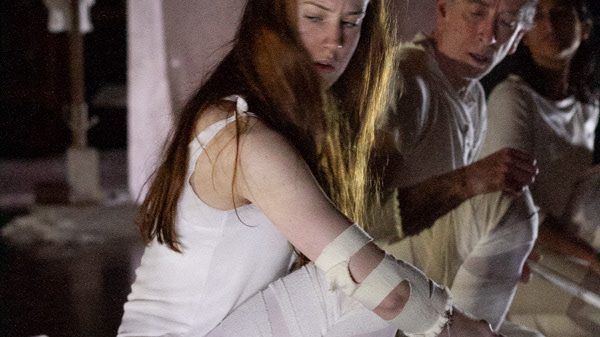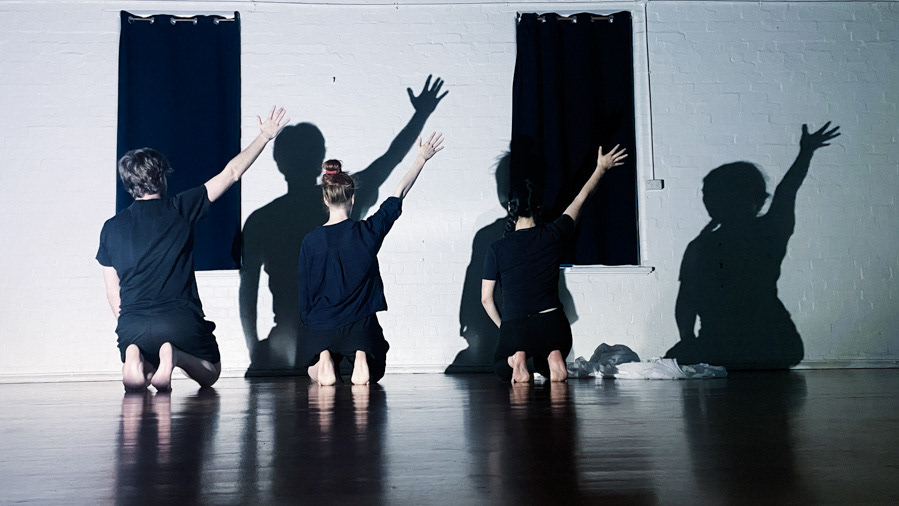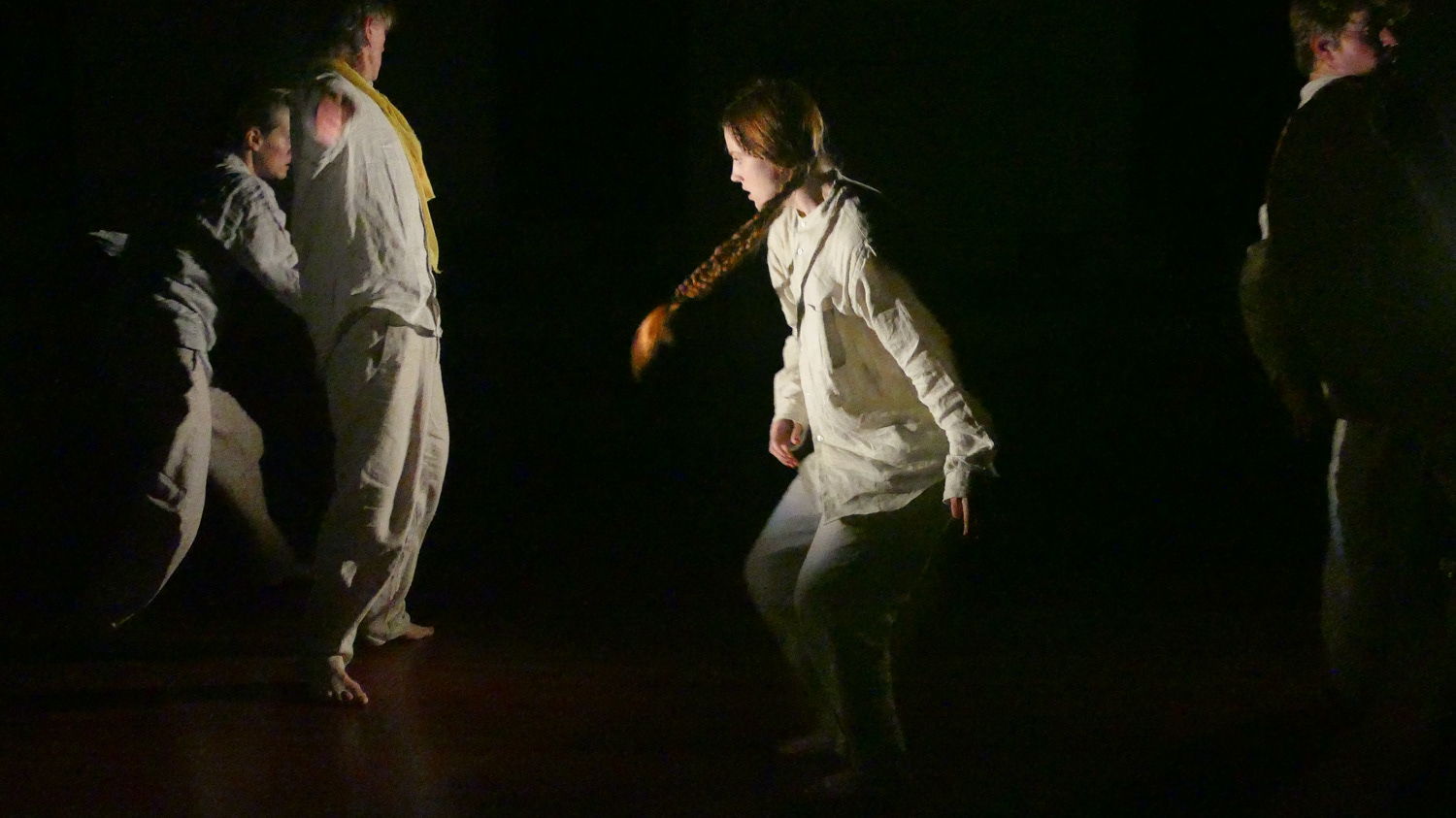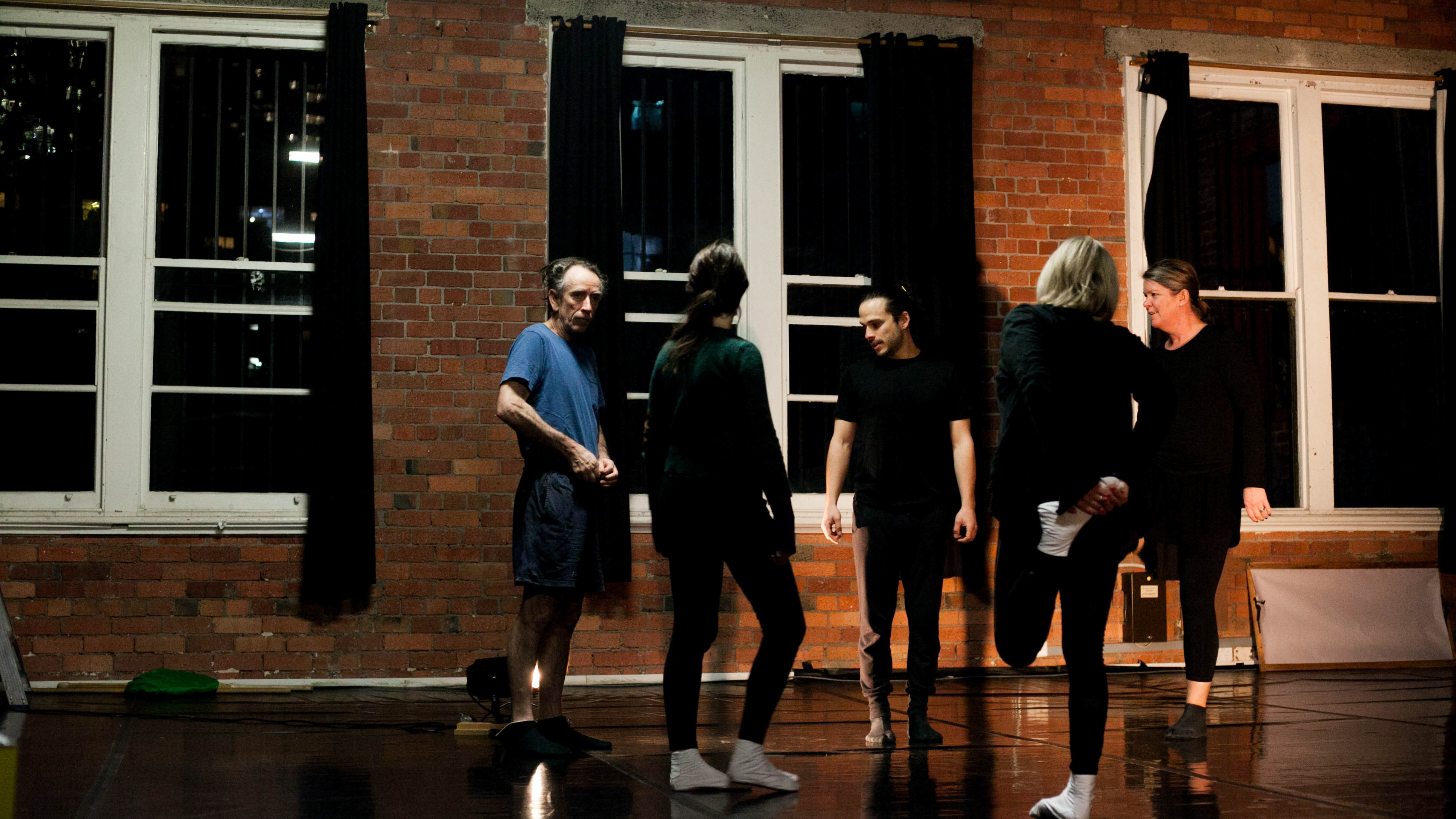Some personal observations after the final day of the 2021 Suzuki Elements Workshop, Melbourne—revised, 2023
Why this training?
Toward the end of the 2021 Suzuki Elements Workshop at The Thursday Group, Rodrigo Calderón, who co-facilitated the workshop, asked me to write something for the participants regarding the question, ‘Suzuki Training… why?’. I supposed a corollary question is why not another acting method? and indeed, during this year’s workshop, for the first time I introduced comparisons to Stanislavsky and Grotowski as a way to provide context for the participants. Before the last day of the workshop, I journaled some thoughts on the question, but the examination led me deeper into my own association with Suzuki training and it has taken much longer than I expected to clarify my thoughts. This essay will seem like an advertisement because I’ve found the many years of training in the method enriching. I do not say it is the only method, I do not say it should be done in isolation from other influences though it might be, but I do oppose the notion that it is somehow a dangerous, culturally specific movement method applicable to a narrow range of performative styles. I don’t intend to argue those points here so much as present some of the detail of the training in the context of the other theatre method influences in my practice. I’ll start with a description of some of the exercises, consider some philosophical questions which the method raises and close with an idea of the benefit the training has offered me.
Toward the end of the 2021 Suzuki Elements Workshop at The Thursday Group, Rodrigo Calderón, who co-facilitated the workshop, asked me to write something for the participants regarding the question, ‘Suzuki Training… why?’. I supposed a corollary question is why not another acting method? and indeed, during this year’s workshop, for the first time I introduced comparisons to Stanislavsky and Grotowski as a way to provide context for the participants. Before the last day of the workshop, I journaled some thoughts on the question, but the examination led me deeper into my own association with Suzuki training and it has taken much longer than I expected to clarify my thoughts. This essay will seem like an advertisement because I’ve found the many years of training in the method enriching. I do not say it is the only method, I do not say it should be done in isolation from other influences though it might be, but I do oppose the notion that it is somehow a dangerous, culturally specific movement method applicable to a narrow range of performative styles. I don’t intend to argue those points here so much as present some of the detail of the training in the context of the other theatre method influences in my practice. I’ll start with a description of some of the exercises, consider some philosophical questions which the method raises and close with an idea of the benefit the training has offered me.
The Exercises
The best way to understand the exercises is to do them, and if that is not possible, to see them. Probably the worst way to understand them is to read them. However, Suzuki Tadashi’s seminal book ‘The Way of Acting’ explains the purpose and generally describes the physical exercises with some interesting black and white pictures.(Suzuki, 1986). Here is a link to the Suzuki Company of Toga (SCOT) where you will find some of Suzuki's reflections on his theatre. The training considers the actor’s physical centre-of-gravity (below the navel) in relation to the aite (相手:companion, contestant, opponent, focal point ), which is a focal point the actor imagines beyond the audience. At all times the actor is content for the audience to watch this relationship. As for the centre, it is considered as the engine that drives expression. Suzuki speaks of the upper body’s vertical space, and the pelvis and undercarriage containing energy that emanates into the horizontal space (pp. 10-11). He continues that stamping on the ground is a gesture that confirms the ‘strength’ of the actor and may lead to the ‘creation of a fictional space, perhaps even a ritual space, in which the actor’s body can achieve a transformation from the personal to the universal’ (p. 12). These are ideas that a western actor may have encountered in Grotowski, Barba, Kantor, Artaud, Meyerhold… there is no shortage. For example, Grotowksi on Barba describing impulses as opposing forces says that ‘This interplay of contradictions, of contractions and relaxations, of the opposite directions of impulses, is carried to such an extreme that one can say that man [sic] is converted, physiologically, into a sign’ (Barba & Savarese, 2006, p. 236). There is much in common with Suzuki training here, and much that distinguishes Suzuki training from other psycho-physical methods in the family of Grotowski/Barba. So, I’ll describe some of the Suzuki exercises generally to show how the method frames the stage as a ritual space and the actor as a sign.
The best way to understand the exercises is to do them, and if that is not possible, to see them. Probably the worst way to understand them is to read them. However, Suzuki Tadashi’s seminal book ‘The Way of Acting’ explains the purpose and generally describes the physical exercises with some interesting black and white pictures.(Suzuki, 1986). Here is a link to the Suzuki Company of Toga (SCOT) where you will find some of Suzuki's reflections on his theatre. The training considers the actor’s physical centre-of-gravity (below the navel) in relation to the aite (相手:companion, contestant, opponent, focal point ), which is a focal point the actor imagines beyond the audience. At all times the actor is content for the audience to watch this relationship. As for the centre, it is considered as the engine that drives expression. Suzuki speaks of the upper body’s vertical space, and the pelvis and undercarriage containing energy that emanates into the horizontal space (pp. 10-11). He continues that stamping on the ground is a gesture that confirms the ‘strength’ of the actor and may lead to the ‘creation of a fictional space, perhaps even a ritual space, in which the actor’s body can achieve a transformation from the personal to the universal’ (p. 12). These are ideas that a western actor may have encountered in Grotowski, Barba, Kantor, Artaud, Meyerhold… there is no shortage. For example, Grotowksi on Barba describing impulses as opposing forces says that ‘This interplay of contradictions, of contractions and relaxations, of the opposite directions of impulses, is carried to such an extreme that one can say that man [sic] is converted, physiologically, into a sign’ (Barba & Savarese, 2006, p. 236). There is much in common with Suzuki training here, and much that distinguishes Suzuki training from other psycho-physical methods in the family of Grotowski/Barba. So, I’ll describe some of the Suzuki exercises generally to show how the method frames the stage as a ritual space and the actor as a sign.
Stomping
Ashibumi, ‘stamping’ is generally translated as ‘stomping’ these days and is a ritual or gestural action that is common to both Noh and Kabuki theatre, though not in the way Suzuki designs it for Suzuki training. In the Suzuki training, the leg is lifted with speed and ‘caught’ by the centre. That is the muscles of the leg rising compress upward into the obstructing force of the pelvis, so the leg may be held in stillness, or immediately released. It’s similar to the action of a coiled spring, which in compression contains potential energy, until a trigger is released. When the leg stomps, that potential changes to kinetic force. Paying attention to equal load descending through the leg and to stomping the foot onto the three points of the triangle of the foot, the actor stomps on the stage floorboards. The floorboards resonate and return the energy through the foot. It travels up the leg and once more is caught and isolated in the centre. If this set of actions is repeated, potential energy gathers in the centre. The attention to the form of the action and the appropriate amount of attack over time, offers stability and challenges the actor to keep the breathing and upper body calm. Stomping is done either on the spot or moving through the space. The movement is done while maintaining the aite relationship so that both the internal and external aspects of the actor’s work are articulated. The exercise is a central part of the training but is by no means the only one. It is employed in three of the five Basic Centre-of-Gravity exercises too, which articulate lateral, sagittal, circular and spinning modes together with vocal expression. I guess 10-20% of the exercises employ stomping in a training session, so to call the training ‘stomping’, as I’ve heard often enough, is perhaps misleading.
Ashibumi, ‘stamping’ is generally translated as ‘stomping’ these days and is a ritual or gestural action that is common to both Noh and Kabuki theatre, though not in the way Suzuki designs it for Suzuki training. In the Suzuki training, the leg is lifted with speed and ‘caught’ by the centre. That is the muscles of the leg rising compress upward into the obstructing force of the pelvis, so the leg may be held in stillness, or immediately released. It’s similar to the action of a coiled spring, which in compression contains potential energy, until a trigger is released. When the leg stomps, that potential changes to kinetic force. Paying attention to equal load descending through the leg and to stomping the foot onto the three points of the triangle of the foot, the actor stomps on the stage floorboards. The floorboards resonate and return the energy through the foot. It travels up the leg and once more is caught and isolated in the centre. If this set of actions is repeated, potential energy gathers in the centre. The attention to the form of the action and the appropriate amount of attack over time, offers stability and challenges the actor to keep the breathing and upper body calm. Stomping is done either on the spot or moving through the space. The movement is done while maintaining the aite relationship so that both the internal and external aspects of the actor’s work are articulated. The exercise is a central part of the training but is by no means the only one. It is employed in three of the five Basic Centre-of-Gravity exercises too, which articulate lateral, sagittal, circular and spinning modes together with vocal expression. I guess 10-20% of the exercises employ stomping in a training session, so to call the training ‘stomping’, as I’ve heard often enough, is perhaps misleading.
The Walks
Other exercises use the experience of stomping in creating different ‘senses’ in the body[1]. Exercises such as The Walks, a traverse exercise, facilitates expressive variation by articulating the contact of the feet to the earth, which creates a variety of senses in the centre. In walks with names like crocodile feet, onnagata (女形: a female impersonation dancer in Kabuki ), scissor-stomp or side-stomp, the actor walks, for example, on the inner or outer blades of the soles of the feet or on the toes. The position of the feet refers up to the centre, and the variations there are felt internally and placed externally. The actor distinguishes one sense from another to develop a vocabulary of body gesture or attitude that may be applied in different ways in a variety of circumstances. Perhaps Laban’s gestural system is another way to achieve this itemisation of the body gesture.
Other exercises use the experience of stomping in creating different ‘senses’ in the body[1]. Exercises such as The Walks, a traverse exercise, facilitates expressive variation by articulating the contact of the feet to the earth, which creates a variety of senses in the centre. In walks with names like crocodile feet, onnagata (女形: a female impersonation dancer in Kabuki ), scissor-stomp or side-stomp, the actor walks, for example, on the inner or outer blades of the soles of the feet or on the toes. The position of the feet refers up to the centre, and the variations there are felt internally and placed externally. The actor distinguishes one sense from another to develop a vocabulary of body gesture or attitude that may be applied in different ways in a variety of circumstances. Perhaps Laban’s gestural system is another way to achieve this itemisation of the body gesture.
Statues
The distinguishable senses developed in the Walks can be used in the more ‘freestyle’ or improvisational exercises such as Statues and their variations, Slow Ten, Moving Statues and more generally, when building and performing a role. The basic Statues exercise has the actor raising the centre from a low squat to a tiptoe stance with explosive speed. The position is held, and the action is repeated according to cues provided by a facilitator, who will vary the rhythm of the poses as they are repeated. At first the actor practices this basic exercise arriving in statue poses with the focal point front, left or right, as it were, facing north, south, west or east in high, low or in between positions. Then poses that express the inner sense of the body are struck. Hopefully, the potential energy generated by the fast movement and stationary pose, and the sense in the centre of each statue will create expression that reaches all parts of the body. The idea that all parts of an artist’s statue cohere with the seed of an inspiration is one of the foundations to which the actor aspires. These inspirations might be conceived by an image, a thought, an impulse, a text, a physical attenuation inside the centre that has been developed in The Walks or in other ways. For example, Michael Chekhov’s detailing of imagination and atmosphere. At The Thursday Group for example, we have used cues such as Egon Schiele’s portraits, and of course inspirations generated from the ideas of a text. The internal sense of the statue is always performed in relation to the actor’s aite.
The distinguishable senses developed in the Walks can be used in the more ‘freestyle’ or improvisational exercises such as Statues and their variations, Slow Ten, Moving Statues and more generally, when building and performing a role. The basic Statues exercise has the actor raising the centre from a low squat to a tiptoe stance with explosive speed. The position is held, and the action is repeated according to cues provided by a facilitator, who will vary the rhythm of the poses as they are repeated. At first the actor practices this basic exercise arriving in statue poses with the focal point front, left or right, as it were, facing north, south, west or east in high, low or in between positions. Then poses that express the inner sense of the body are struck. Hopefully, the potential energy generated by the fast movement and stationary pose, and the sense in the centre of each statue will create expression that reaches all parts of the body. The idea that all parts of an artist’s statue cohere with the seed of an inspiration is one of the foundations to which the actor aspires. These inspirations might be conceived by an image, a thought, an impulse, a text, a physical attenuation inside the centre that has been developed in The Walks or in other ways. For example, Michael Chekhov’s detailing of imagination and atmosphere. At The Thursday Group for example, we have used cues such as Egon Schiele’s portraits, and of course inspirations generated from the ideas of a text. The internal sense of the statue is always performed in relation to the actor’s aite.
The Voice
There are many more exercises, but perhaps this is sufficient to continue to the vocal aspects of the training and the method’s wider purpose. The default setting for Suzuki Training vocal technique is that the centre is the seat of the voice, and for this reason, at Thursday Group, we have come to use the now familiar term body/voice and recently ‘gesture/voice’. The energy, control and sense that is developed in the physical is utilised in the vocal aspect. By creating a strong platform of control and energy for the seat of the vocal column, below and at the diaphragm, while maintaining the breathing, resonance and articulation apparatus open and calm, a dense timbre is achieved. By this I mean, whether the volume of the sound is loud or soft, the resonance and focus of the voice is strong and remains expressive. In my view, it is here that the greatest misconceptions concerning Suzuki Training arise. In the first place, it is important that the actor doing voicework in Suzuki training understand that all their acting experience will be useful, including their prior vocal practice. Often enough I’ve seen examples, but nowhere does the training demand that the actor shout in a monotone–something is wrong if this is the case. Rather, my advice is to speak to the target of the communication, which is to say, to another actor or to the aite, and indirectly or directly, to the audience. The physical aspects of the training are always aerobically challenging yet the actor must be prepared to speak. So, embodied actions are always done with the breathing centred, that is, with a readiness to communicate inner life with verbal or intoned expression. In this way, the voice gains a vital interaction with the expressive senses of the body, and thus we arrive at the term body/voice. It’s a tautology really, because of course the voice issues from the body… how could it not? Perhaps the emphasis is necessary in the contemporary theatre where acting is so influenced by film acting, which favours the face over the body as the tool of expression.
Carry the Energy of the Thought to the End
The exercises demand that the actor speak with a vocal sense that is appropriate to the physical one, so if the body changes from one gesture to another, the voice will change. Long hours have we spent in our Thursday Group laboratory analysing this point, for example, is it possible for the meaning of the text to vary the vocal expression while the body remains still. How does the voice change the body? Notions of ‘thinking the thought’ that are common to the western tradition of text interpretation in theatre have parallels here and form interesting avenues of experimentation in our work with the training. My understanding of the Suzuki Training vocal exercises is clouded by my prior and subsequent experiences to working with the Suzuki Company of Toga. But Suzuki Tadashi is clear regarding the relation of energy to voice because he notes the relationship between an arc of movement that ends in holding the body still, and the arc of vocal energy that must meet the completion of the idea, which is usually at the end of a sentence. The co-relative in western vocal training might be the advice to carry the thought to the end of the line. So, in our work at The Thursday Group, we have found no contradiction in synthesising Clifford Turner or Cecily Berry and other voice practitioner-theorists with Suzuki Training, for example Clifford Turner or Cicely Berry (J. Clifford Turner, 1966; Voice And The Actor by Cicely Berry, n.d.).
Truth and Rationale
Because my own foundational training was in a version of Stanislavsky’s method, like so many, I have judged acting according to whether I consider it is ‘truthful’. The term is obviously quite problematic, especially when speaking not on verifiable facts but on artistic expression. In The Thursday Group’s training, we have often considered the nomenclature, for example when doing The Statues exercise. We shied away from the loaded term ‘truth’ favouring words like ‘rationale’ or ‘logic’, and this was measured on scales of an actor’s own assessment or the perceived assessment of appropriateness between the vocal and the physical expression or the inner life and the external presence. When a person sees a performance, they too may make micro-judgements concerning the ‘truth’ of the acting, which will contribute to an overall assessment of the success of the performance. In western theatre, this judgement is likely made according to the dominant theatrical style which will often be derived from the Strasberg or Adler versions of Stanislavsky. David Richard Jones offers three criteria to understand Stanislavski’s central theme of ‘truth’: correspondence, which demands the actor provide a verisimilitude to real life; coherence, in which the actor performs within the stylistic and fictional boundaries of the play; and lastly, the spiritual meaning of life (1986, p. 74). Concerning the third criterium, Stanislavski said, ‘The fundamental aim of our art is the creation of this inner life of a human spirit, and its expression in an artistic form’(Stanislavski, 1948, p. 15). Preceding this statement, Stanislavsky considers the terrible predicament of the actor who must create an inner life from their subconscious intuition, but the moment they apply conscious intent to the task, the subconscious ‘dies’. The first two of Dean’s tenets, correspondence and coherence, are not contradictory to the Suzuki training, and depend as much on the work of the director as the actor. Regarding the third aspect of spiritual life, I think the Suzuki training has much to offer because the life and death attempts the actor makes to meet the extremes of the training provide not fictional but actual physical challenges. The energy that they accrue in their struggles is not imaginary, and often leads to a transcendent state that might equate with the term ‘inner life’. That is, the actor is in touch with an authentic expression of the spirit. An actor that works in psychophysical theatre training will experience this and The Suzuki Method is no exception. I have found that applying it in a wide range of theatre performances assists the creation of ‘authentic’ performance.
Existence
In rehearsal, the first moment an actor crosses the line from off to onstage, sometimes with script in hand, sometimes with a faint improvisational map, they may feel awkward because they are unsure of the world into which they step and the identity of the person they play. Suzuki training provides the actor with an existence onstage that allows them to wait, act or react as the case demands. The foundational idea of the training is the relation of the actor to the aite as watched by the audience. Grotowski calls this the actor’s ‘secure partner’, as James Slowiak and Jiairo Cuesta state, “this special being in front of whom [an actor] does everything, in front of whom he plays with the other characters and to whom he reveals his most personal problems and experiences”(Stanislavski, 1948, p. 15).
Bringing the lessons of an attention to the centre to this relationship, the actor carries a resistance in the centre, that is the potential for action controlled by an opposing force to hold still. Suzuki uses the metaphor of a race car at the starting line with the engine on and revving hard but with the brakes applied. The car has much energy but is held still by an opposing force. The field of potential energy that infiltrates the actor-aite relation becomes a stable platform from which the events and expressions of a drama between actors may unfold.
Self-Evaluation and Transcending the Personal
Many actors are concerned with their own craft and judge themselves too harshly. In providing the actor with the internal attention to initiate all expression from the centre outwards, with the unswerving demand to focus on the aite, and by inviting the audience to witness the communication between actor and aite, their judgement of self-worth becomes less important. At times, the actor’s anxiety concerning practice can be debilitating. Especially in younger actors, the lingering doubt of their ability in comparison to their mentors and idols has negative effects on confidence, and if left unchecked, may lead to their withdrawal from the craft. In Suzuki training this problem seems less pronounced. All the original exercises are immutable. The actor assesses the appropriate challenge for their age, their weight, how tired they are today and so on. Because they will never achieve the mostly impossible forms of the exercises, they can measure how near or far they are to the mark. This attention to themselves in the context of achieving what becomes a well-known set of problems normalises the ongoing process of self-assessment. Through experience, an actor will become more adept, the distance to the perfection of the form of an exercise will narrow and they must increase the challenge with which they attack. The attempt is the objective. In this way, from the moment the actor starts learning the training they are doing the training, and during the different stages of their career, they will notice new aspects, develop new problems, understand other actors’ approaches and apply the training in ever unfolding ways. In short, they will never stop deepening their understanding. So the search for understanding remains constant whether it is a novice or experienced actor searching. By corollary, no actor has greater value in light of another. For me, this has provided me with a freedom to pursue lines of investigation with my art without negative self-doubt. It has opened me to the greater objective of pursuing goals of interrelation in ensemble. In plain terms, through this team approach to the challenges of acting, my actor’s sense of self transcends into a sense of the ensemble and into a sense of the overarching composition of a performance as it is viewed by the audience.
The Ground
The actor’s sense of relation to the aite, the ability to create force and to resist it, the gaining of stability in the centre cannot be achieved without attention to the human relationship with the ground. Suzuki Tadashi’s discussion regarding the domestication of the human body comes to me. In using chairs, we have removed ourselves from the ground. It was the case that if we wished to consider the stars we could lie back on the ground, whereas now we sit in chairs craning our neck. The safe ground of the earth that was the foundation of all movement has been partially lost. Reclining on a chair, our legs dangle almost unused, which means the musculo-skeletal system withers and the body’s sense of itself is reconfigured. The reconfiguration is entrenched, so it has become unacceptable to sit on the floor in many societies. The signs of the human body, its internal personal identity as well as its social and environmental interaction loses an authenticity because it is by lifting and lowering the body that the body first comes to know itself. The artificiality that chairs bestow doesn’t suit the actor’s need to refer to existential questions, which are the endpoint of all stage arguments. The sofa drama has become so prevalent that these days, if an actor squats, kneels on what Suzuki Tadashi would like to be ‘sacred’ stage-boards or exhibits a facility in descending to or rising from the ground, they are congratulated on their abilities in ‘Asian theatre training’ as if there were something specifically cultural in such acts. In remembering the relation with the ground from which we come and to which we return, perhaps the actor makes a kind of subversive cry to the metropolis, a reminder that we are firstly animals and that all socio-cultural identities exist within the wider, undeniable ecology of the earth.
Energy
In his book, one tenet of Noh theatre that Suzuki cites is that this Japanese classical theatre tradition, derived from propitiatory folkdance, eschews non-human or ‘inert’ energy, and explains that in the 1960’s, Grotowski in ‘Towards a Poor Theatre ‘and others in Europe led a movement of theatre that focused on the energy of the actor too (Suzuki, 1986, p. 29). This human energetic approach allows the actor to explore the extremities of their instrument. In Suzuki’s theatre, he usually (always?) demands that actors provide as much energy as they can, and more. It’s well that the actor trains with as much potential or kinetic energy as possible because these extremities create the best measures of their performance of the exercises and offer the audience the view of an actor transcending. But perhaps in the application of the training, it is the actor’s choice how much of this energy is expressed. It is here that I diverge from Suzuki’s theatrical aesthetic, because while my own theatre uses these extremes, it also plays on a spectrum of expression. Put another way, I allow the energy to fall within the actor so that not just an in theory one-hundred percent energy might be seen, but also a ‘zero’. I would therefore say that epic or lyric theatre styles are also facilitated by the training. Actors that retreat from the forwardly pressing relation of the aite are just as vital and display just as much focus. Remembering Suzuki’s discussion in the masterclasses in Toga of 1991 concerning rearwards focal points that must be considered by the actor, I wonder whether there is any conflict here. That is, perhaps Suzuki creates this attenuation by means of the direction of energy rather than the quantity of the force?
Mystery
The idea of Yugen (yugen:幽玄用ゆうげん–mysterious profundity, penumbra ) is used in all forms of Japanese art, and it could be argued Asian art, for example, it’s seen in the white space of Chinese scrolls where material objects fade into the whiteness of an immaterial world. And it is used in the ghost stories of Noh theatre, in which Johakyu (Johakyu: 序破急 ‘a modulating style’. ‘Jo: begin in an easy manner; Ha: develop dramatically, Kyu: finish’ rapidly) (Motokiyo Zeami, 1984; Yamazaki Masakazu, 1984, p. xliii) and other techniques help the actor not just to imagine altered states, but also to experience them physiologically by engaging in acts that create challenges of control and resistance in the centre and in maintaining control of the breath and vocal apparatus. This yugen space is sometimes called ‘negative’ space, a concept we have experimented with extensively at The Thursday Group. It is one of the ways that variations may be developed. I hope that because concepts of negative space are common throughout the world, the knowing use of the Japanese instance in yugen might not be thought of as cultural appropriation, and its use may extend into the application of training to performance and indeed to theatre making. An excellent discussion of yugen here (Odin, 1985).
In conclusion… Resilience
That’s already quite enough concerning my interpretations of the Suzuki Method of Actor Training. On a personal note, I will close with the beneficence a regular training regime has offered me. Actors are often left alone in their bedroom to consider what’s next. Theatre is an expensive and difficult craft to practice when so much of theatrical life is ‘freelance’. So even though collaboration is the air that actors breathe, it is often denied them. Aside from performance and leaving the deep philosophical and psychological concerns of surviving in theatre aside to focus on the simple physical presence of actors in the space is liberating, especially when it is done several times a week over many years. In Suzuki training with The Thursday Group therefore, I have found a tool that guards against the precarity of interactive opportunity and a resilience in the development of my craft. Our group maintains the basic forms of the exercises as I learned them all those years ago, and we create variations, or experiment using the first principles of the training as we define them. We also bring other methods such as Grotowski and the examination of ‘impulse’ to bear, and we incorporate vocal training from Clifford Turner. In this way, we create a stable platform on which to build actor practice within the group’s performance development. These practice development experiments through the relation of first principles to imaginative variations often creates performance vocabulary and is a major source in co-devising performance. This was seen recently in our co-devising project Orpheo Machine, in which I brought research on Lev Vygotsky’s notion that the inner thought is completed in its social expression to our performance-making. Sometimes I wonder if I would still be acting, writing and directing in theatre if not for the ability to show up for training, practice and performance development on a regular basis. For that, I thank the Suzuki Company of Toga and its director Suzuki Tadashi for providing me with the tools of my practice.
Bibliography
Barba, E., & Savarese, N. (2006). A dictionary of theatre anthropology: The secret art of the performer (UniM Bail 795.03 BARB; 2nd ed.). Routledge. https://search.ebscohost.com/login.aspx?direct=true&AuthType=sso&db=cat00006a&AN=melb.b3019013&site=eds-live&scope=site&custid=s2775460
J. Clifford Turner. (1966). Voice and Speech in the Theatre. Sir Isaac Pitman & Sons Ltd.
Motokiyo Zeami. (1984). On the Art of Nō Drama: The Major Treatises of Zeami (Y. M. J Thomas Rimer, Trans.). Princeton University Press.
Odin, S. (1985). The penumbral shadow: A Whiteheadian perspective on the yūgen style of art and literature in Japanese aesthetics. Japanese Journal of Religious Studies, 12(1), 63–90.
Slowiak, J., & Cuesta, J. (2007). Jerzy Grotowski. Routledge. http://ebookcentral.proquest.com/lib/unimelb/detail.action?docID=292746
Stanislavski, C. (1948). An Actor Prepares. Taylor & Francis Group. http://ebookcentral.proquest.com/lib/unimelb/detail.action?docID=668654
Suzuki, T. (1986). The way of acting: The theatre writings of Tadashi Suzuki (J. T. Rimer, Trans.; UniM Giblin Eunson 792.0952 SUZU; 1st ed.). Theatre Communications Group.
Voice And The Actor by Cicely Berry. (n.d.). Retrieved 8 March 2021, from https://www.penguin.com.au/books/voice-and-the-actor-9780753546925
Yamazaki Masakazu. (1984). The Aesthetics of Ambiguity: The Artistic Theories of Zeami. In Y. M. J Thomas Rimmer (Ed.), On the Art of Noh Drama: The Major Treatises of Zeami (pp. xxix–xlv). Princeton University Press.
[1] ‘Sense’ has a long listing in the OED. Here I mean the rationale or logic of the body, but also the earlier meaning of the word that connects to memory, imagination and soul. Sense relates to a physical communication that is intelligible. Suzuki uses ‘sensibility’ or ‘aesthetic’ in the same context.

